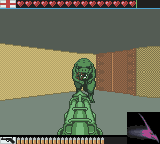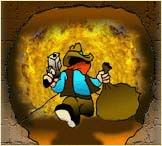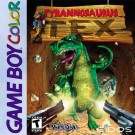![]()
A first-person shooter on the Game Boy Color would seem to be a challenge by anyone’s standards, so it should come as little surprise that Tyrannosaurus Tex was created by someone with an urge to do what no-one had done before. Having left Psygnosis after working on titles like the Colony Wars series, Ben John founded UK-based Slitherine Software and set about flexing his coding muscles. After considering a Command & Conquer-style RTS game, he settled on an FPS and began work on a tech demo in early 1999. Enlisting the help of his friend Dan Crawley (concept/character art) and father Mike John (designer), the demo was displayed at the 1999 European Computer Trade Show and attracted the attention of publishers such as Codemasters, Take2 and THQ. The game was ultimately signed-up by Eidos, who added producer Iain McNeil to the team. Full production began in September 1999 with a planned release date of April 2000.
The plot for their ambitious title: One day, the Texan desert town of Eastwood is witness to a spaceship crash, its contents a horde of sinister robots. They not only set about fixing their ship, buried underground in the crash, but also start building a replica of their world and growing dinosaurs from the remains found beneath the earth. All is well until humans begin digging for oil, and the robot/dinosaur masses attack. Tex is approached by an oil company and offered a handsome reward to fix the problem. Some descriptions of the plot mentioned a diamond mine, and that a gem-loving Tex would have to rescue the townsfolk.
The controls were simple by necessity – A to shoot, the D-pad to move around (holding B to strafe), Select to cycle through weapons and Start to pause and bring up a scrolling overhead tile map of the current area.
Tex would start off in a mine before plunging deep into an underground city; a later level would have sent him aboard the crashed spaceship. In all, 28 levels were planned including an end of game boss. Some levels would have been timed and set inside maze-like caves in danger of imminent collapse, while the rest were busier with enemies, light puzzle elements, keys, doors, traps and forcefields, with no time-limit but the same task of surviving to the exit. When all the diamonds were collected in the level a secret area would be unlocked, containing a collectable rune. In all, Slitherine estimated it would take twenty hours to complete the game normally and forty if all of the runes were sought out.
The cowboy would find six types of gun on his journey. Starting off with a reliable-but-weak Colt which could fire at a reduced rate without ammo, Tex would progress to an improved Colt, grenade launcher, continuously-firing laser, guidable harpoon and finally a secret high-tech weapon. Tex was to go up against ten types of enemy; they would either follow a specified route (Routers, such as robots and, deviating randomly from their path, the bats and rats) or head towards the player (Hunters, such as the King T-Rex and velociraptors). Fast-moving Trundle Bots would appear in groups and steal Tex’s ammo on contact. Some strategy would be required, for while the grenade launcher was effective against all classes of enemy, a laser would merely tickle a dinosaur’s scales, whereas a much better-suited harpoon would only deal low damage to the steel body of a robot. Whichever way they were defeated, enemies would break up into four tiles, exploding away from each other toward the corners of the screen.
Among the game’s features: stereo sound (Shin’en Audio Outsourcing Services provided the music), around 10 levels of faux scaling, up to 16 objects on screen, 3 battery-backed up save slots, a 3D engine running at 20-30fps, and 100 high-colour intermission screens which took up half of the 16-megabit cartridge.
An FPS engine on the Game Boy Color was ambitious enough, but Slitherine were to cram in a two-player deathmatch mode as well, a tall order given the bandwidth limitations of the system’s link cable. Players could choose from Tex (starts with Colts, can use any weapon), Hover Robot (may only use a laser, vulnerable to lasers, very fast), Close Combat Droid (started with a laser, may pick up weapons, vulnerable to lasers), Tank (started with a slow-reloading grenade launcher, also vulnerable to lasers) or a ferocious T-Rex (best at close-combat, having only claws for weapons). Only Tex and the first arena were available from the beginning; the other characters and 4 additional levels would unlock through finding runes in single-player mode.
The game was delayed, and its original release date came and went, pushed back to the end of the year. There was a huge setback, too: Eidos pulled out of the Game Boy Color market and left Slitherine without a publisher, though they did gain a new team member as Iain McNeil chose to stay with the company, bringing along his father as business/financial manager. The in-game artwork, unchanged since the tech demo, was at some point contracted out to be redrawn by bitmap artist Fad Stevens, who also later joined the company. By this time, there were rumblings that the preview screenshots were fake, that proper coding still hadn’t begun. But in August of that year IGN played an early build of the training level and were impressed with what they saw, although they found the AI to be rather weak, and screenshots were noticeably emptier than the jam-packed scenes portrayed in earlier previews, perhaps both due to the nature of the level previewed. They also reported that Slitherine had found a new publisher, and that the game would finally be released in January 2001.
Slitherine announced that the game was complete. However, by April 2001 the company still hadn’t secured a publishing deal (some of the names approached including SCI, Telegames and Take 2). Among the difficulties cited were Nintendo’s high royalty rates for purchasing cartridges and the low margins resulting (exacerbated by the game’s size and battery save) and the lack of a big-name license. Though they continued to seek a publisher for Tex, and briefly considered developing for the Game Boy Advance (interestingly their website contained two animated T-Rex sprites with palettes more suited to the GBA), by the end of the month Slitherine chose to pull out of all future Game Boy development. Tyrannosaurus Tex never did make its way onto store shelves, but the company survives to this day, developing and publishing strategy titles for the PC and other major platforms.
Thanks to Ross Sillifant for the contribution! (United Game interview with Slitherine Software)
March 2013 Update: A rom of a prototype version of the game has been released online, details are at nintendoplayer.com
Images:

































